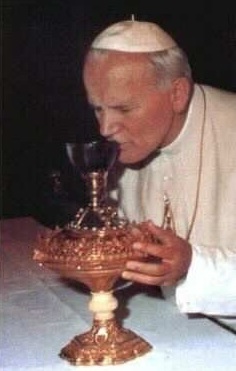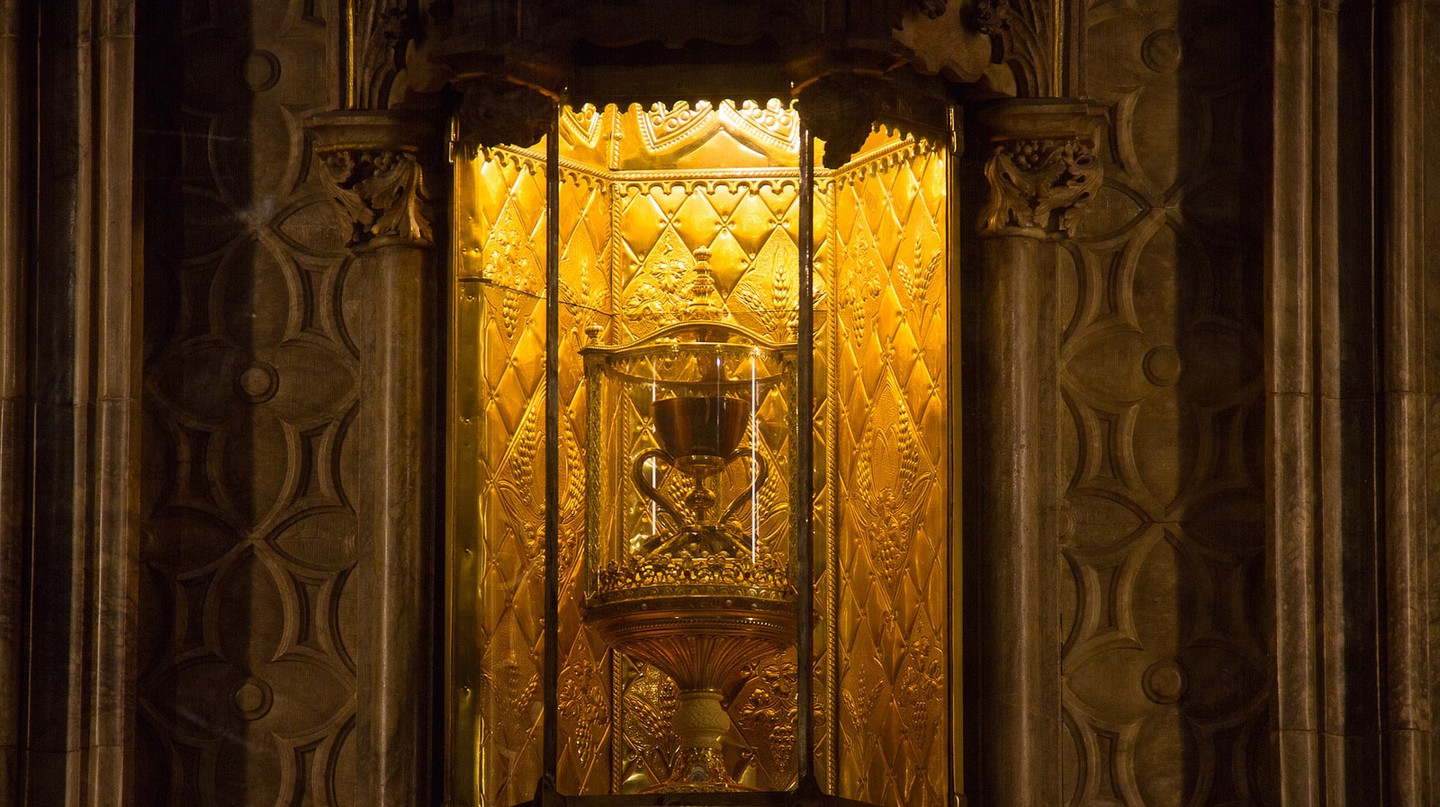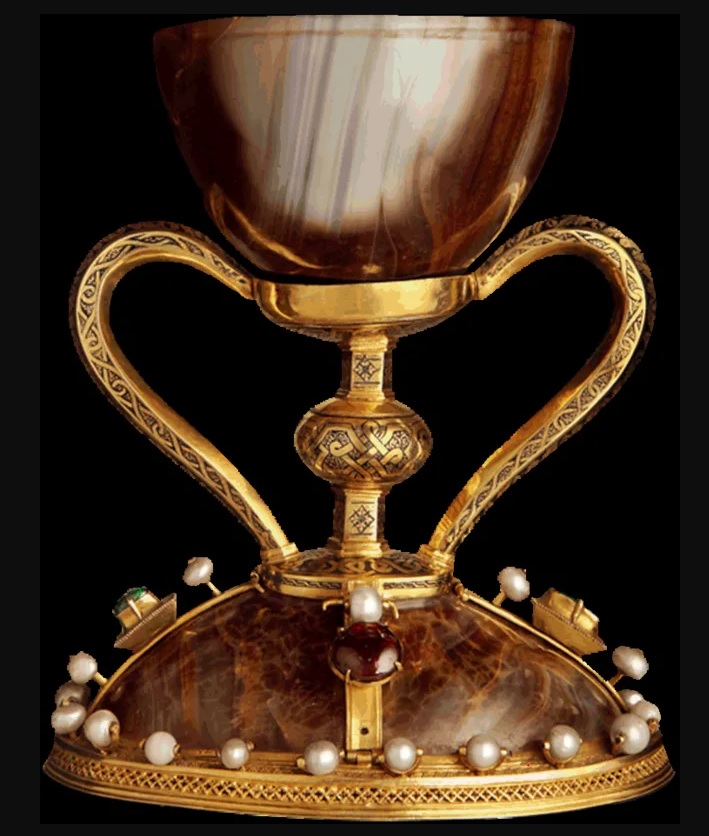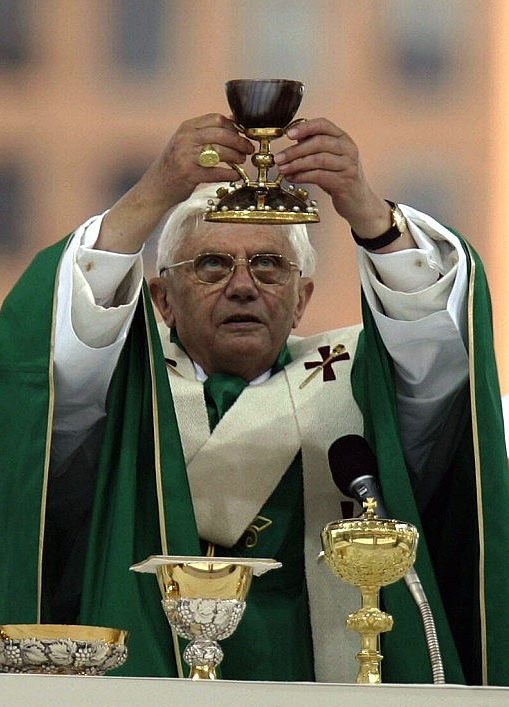I've been convinced ever since I read A Catholic Quest for the Holy Grail by Charles Coulombe and wrote this.
From Fr Z's Blog
On this Feast of St. Lawrence this seems appropriate.
The Holy Grail might be in Valencia, Spain.
 There is an interesting book by Janice Bennett entitled St. Laurence and the Holy Grail: the story of the Holy Chalice of Valencia (Ignatius, 2004) which argues that the 1st century cup of agate, now mounted on a medieval base of gold and precious stones is the cup that Jesus used at the Last Supper for the consecration of His Most Precious Blood, “poured out for many for the forgiveness of sins.”
There is an interesting book by Janice Bennett entitled St. Laurence and the Holy Grail: the story of the Holy Chalice of Valencia (Ignatius, 2004) which argues that the 1st century cup of agate, now mounted on a medieval base of gold and precious stones is the cup that Jesus used at the Last Supper for the consecration of His Most Precious Blood, “poured out for many for the forgiveness of sins.”
For many, not for all… in the sense that not all will accept the gift.
Please understand that this book has big holes, uneven writing and research, and is open to serious skepticism on some aspects. However, it also relates truly fascinating information about this amazing relic held in Valencia and gives the reader a glimpse into the story of St. Lawrence and translations of various manuscripts of interest. Take this with a grain of salt, but it is a great read.
The cup itself is of a kind of agate, like chalcedony or sardonyx. It is like other cups found in Egypt, Syria and Palestine at the time of Christ. In the British Museum there are stone cups of the same style as that in Valencia dating to A.D. 1-50. It is of an odd color, reddish, “like a live coal”, and it is hard to say exactly what the stone is. The ancient naturalist Pliny describes that stone cups were submerged in oil until the stone absorbed some, and then boiled in acid which modified the organic material and changed the colors of the veins in the stone. The cup was very finely and accurately crafted and lacks ornament other than a fine band around the lip. It was broken in the middle on 3 April 1744, Good Friday, when it was dropped. I’ll bet that guy was reassigned! The break was repaired and only a tiny chip is missing. The cup can hold about 10 ounces.
You are asking, “But Father! But Father! How can anyone claim that this cup in Valencia came from the hands of Jesus in Jerusalem?”
The cup has an interesting story, traced by Bennett in her book. Here is the super brief version.
Some scholars argue that Christ used two different cups at the Last Supper, one of metal and the other of agate, the latter used for the first consecration. Some argue that the Upper Room used for the Last Supper belonged to the family of John Mark. There is some confusion about the different “John”s and “Mark”s in the New Testament. Suffice to say that it is possible that Mark the Evangelist was the son of the women who was a prominent member of the first Christians in Jerusalem. Peter went to her house when he was released from prison. That house was a meeting-place for the brethren, “many” of whom were praying for Peter when he was in prison: (Acts 12:12-17). This is possible the same place where the Last Supper took place, which establishes a connection with Mark and with Peter. It is argued that Mark gave Peter the cup Jesus used at the Last Supper for the consecration of his Precious Blood. This would be the second cup Jesus handled that night.
St. Peter consequently took the cup with his to Rome, where the Prince of the Apostles used it for Holy Mass until his martyrdom under the Emperor Nero. Thus, this cup became a precious object within the Christian community in Rome.
 |
| Sixtus II ordaining Lawrence to the exclusively all male diaconate |
Bennett relates the argument that the presence of and even use of this cup in the ancient Roman Church is proposed as a possible reason why in the Latin Rite our consecration formula speaks of “hunc praeclarum calicem… this precious chalice” whereas the non Latin rites refer to the Greek “to poterion… the cup”. Interestingly, in the New Testament the word used is poterion, “cup”, and in Latin it is calix. However, in Spanish the word caliz (in Italian calice) is used to distinguish this important vessel for Mass from a simple cup, or copa (Italian coppa). “Cup” is simply not worthy of the moment and the purpose. Where do the words involved here come from? A Greek kylix was ceramic and had a wide base, was shallow, and had handles parallel to the table along the wide open lip. This style also came to be made from precious metals. The Romans called this cup a calyx. The word “grail” probably derives from old Spanish gral, grail for a drinking vessel, perhaps coming from Latin gradale or grasale a wide dish. In Provençal, the language of many of the troubadors who spread the grail legends, we have grazal.
During the time of the Emperor Valerian there was a terrible persecution of Christians. In A.D. 258 Pope Sixtus II was commanded to turn over the goods of the Church and, when he refused, was killed. Sixtus, however, had entrusted to his deacon the goods of the Church for their administration. This deacon was the famous St. Lawrence, a Spaniard from Huesca. When the Emperor went after Lawrence and commanded that the goods of the Church be rendered up. Lawrence asked for three days to get everything together. But instead of giving it to the officials he gave everything away and then produced a group of poor people, saying “These are the true treasures of the Church”. For that Lawrence was beaten and tortured horribly, even to being fried alive on an iron grate. For his part, however, Lawrence had already given the precious stone cup to another Spaniard named Precelius, who took it to Spain. The iron grid of Lawrence’s martydom is preserved in a Roman Church just a few minutes from where I am writing, in San Lorenzo in Lucina though he was martyred where there now stands San Lorenzo in Panisperna and buried at San Lorenzo fuori le mura, a Minor Patriarchal Basilica.
Lawrence is obviously the patron saint of cooks as well as several other groups. [cooks!]

Perceval
This is where the history firms up a bit. Various manuscripts indicated that the stone cup was kept in several places. By 533 it was in the Cathedral of Huesca, which was built in that year. Huesca was where St. Lawrence was from and perhaps where the Spaniard Precelius took it. After the 711 invasion by the Moslems it was hidden in the Pyrenees in various caves. After Charlemagne’s journey to the area in 777, the location of the cup, which was hidden, roused up many of the “grail legends” that come down to us in many forms today. In 830 the cup is at the Monastery of San Pedro de Siresa. In 1071 it was taken to the monastery of San Juan de la Peña. In 1190 Cretien de Troyes wrote a 9324 line poem Perceval about the “Holy Grail”. In 1209 Wolfram von Eschenbach wrote Parcival, based on Spanish legends, which centuries later inspired Richard Wagner’s opera. In 1322 a Sultan sells a gold cup from Jerusalem, which he claims is the cup of the Last Supper, to Jaime II, King of Valencia and Aragon. This is perhaps the cup which is converted to become the base for the ancient stone cup. In 1399 the stone cup was given to King Martin the Humane and taken to Barcelona. King Alfonso V of Aragon sends the cup to Valencia. In 1744, the cup is broken, repaired and fixed to its base. In 1936, to save it from the Marxists, a woman named Maria Sabina Suey smuggled the cup out of the Cathedral wrapped in newspaper. She hid it in various places to keep it from desecration and destruction. The cup returns to the Cathedral of Valencia in 1939 with the end of the war where it remains to this day.
Even if this is not the very cup Jesus used at the Last Supper, and it might well be, it is hard to dismiss that this is the cup that inspired all the Holy Grail legends which branch into the stories of the Knights of the Round Table, an Indian Jones movie, and another recent piece of rubbish not worth our time to name.
 The ancient stone cup, on its golden medieval base, is now in a beautiful chapel in Valencia. When Pope John Paul II visited Valencia on 8 November 1982, he kissed the cup (better than kissing a Koran) and then used it to celebrate Holy Mass.
The ancient stone cup, on its golden medieval base, is now in a beautiful chapel in Valencia. When Pope John Paul II visited Valencia on 8 November 1982, he kissed the cup (better than kissing a Koran) and then used it to celebrate Holy Mass.
It might have been the first time, 1724 after Pope Sixtus II, that “Peter” had held the cup again.
Pope Benedict used it for Mass in Valencia.
It could really be it, after all.




No comments:
Post a Comment
Comments are subject to deletion if they are not germane. I have no problem with a bit of colourful language, but blasphemy or depraved profanity will not be allowed. Attacks on the Catholic Faith will not be tolerated. Comments will be deleted that are republican (Yanks! Note the lower case 'r'!), attacks on the legitimacy of Pope Francis as the Vicar of Christ (I know he's a material heretic and a Protector of Perverts, and I definitely want him gone yesterday! However, he is Pope, and I pray for him every day.), the legitimacy of the House of Windsor or of the claims of the Elder Line of the House of France, or attacks on the legitimacy of any of the currently ruling Houses of Europe.